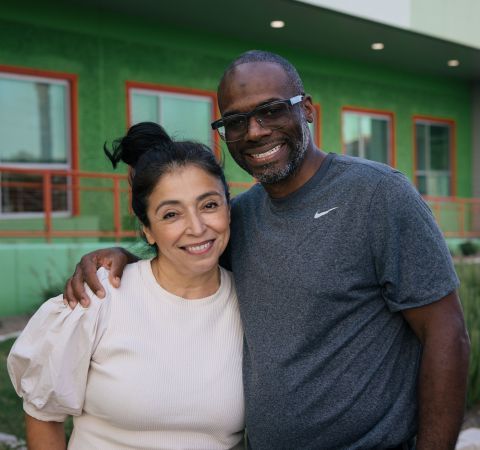Hunger and poverty in America
In America, many people work hard every day, but sometimes affording food and housing is a challenge This situation is called poverty. While income plays a role, poverty affects people from all walks of life. It's especially difficult for families with children, people of color, and people with disabilities.

What is poverty?
The U.S. government uses income to measure poverty. A family of four needs more than $30,000 a year to afford basic necessities. But poverty is more than a number. It can make it hard to access the things we all need to thrive, like healthy food and a safe place to live.
Facts about poverty in America
Many people in America face challenges getting the food and resources they need to live healthy, full lives. Here are some facts about poverty in America.
-
 In the US, a family of four earning under $30,000 a year is considered low-income.
In the US, a family of four earning under $30,000 a year is considered low-income.The federal poverty line helps identify families who might need extra help with things like food and housing. The government sets this number each year.
-
 In 2023, over 36 million people lived in poverty, according to the Census.
In 2023, over 36 million people lived in poverty, according to the Census.However, two-thirds of the people facing food insecurity in America reported incomes above the poverty line. Source: Census
-
 People of color are more likely to experience poverty.
People of color are more likely to experience poverty.People from all different races and backgrounds can experience poverty. But it is more common for people of color because of racism and discrimination.
-
 People with disabilities and chronic conditions are also more likely to experience low incomes and hunger.
People with disabilities and chronic conditions are also more likely to experience low incomes and hunger.Living with a disability and chronic conditions is more difficult, and healthcare is expensive. People living with disabilities may be unable to work or face discrimination in employment.
Causes of poverty
Poverty is a complex issue with many causes. Here are some of the most common causes of poverty:
Low wages and unemployment
Many people who work full-time or multiple jobs still don’t earn enough money to make ends meet. People with disabilities and chronic conditions may not be able to work or paid fairly.
Lack of affordable housing
Housing is expensive, making it difficult for people to afford a place to live. This can lead to homelessness or living in unsafe or overcrowded conditions.
Racism and discrimination
People of color, women, and people with disabilities are more likely to have low incomes because of discrimination. This can make finding housing, jobs, and other opportunities difficult.
Education and healthcare
People without education and healthcare may have difficulty finding and keeping good jobs. This can often keep people stuck in low-wage work.
Effects of poverty
Many people in America want to take care of themselves and their families without relying on others. However, poverty can make it difficult for people to achieve their goals. Poverty can make paying for necessities like food, shelter and healthcare hard.
Food insecurity
People living in poverty may not have enough money to consistently afford healthy food.
Poor health
People living in poverty may have less access to healthcare and healthy foods.
Education
Children living in poverty may be less likely to attend higher education, making it difficult to get a job that pays a livable wage.
Ending hunger and fighting poverty
To end hunger, we need to make sure that everyone has enough money to buy healthy food. This requires working with communities facing hunger to achieve economic security.
That’s why Feeding America’s work goes beyond helping people get food. We also help people facing hunger improve their economic opportunities through federal and local programs:

Expanding programs like SNAP
In 2022, SNAP helped nearly 40 million people put food on the table. It’s one of the most effective ways to end hunger. But more than 7 million people don’t know they qualify. Our SNAP counselors help people understand, apply for, and access benefits.

Partnering to help people increase their income
The most common cause of food insecurity is low income. That’s why the Feeding America network explores new ways to support communities beyond food through job training, workforce development, and business enterprises.

Investing in solutions to root causes
We’re investing in the work of the people most affected by hunger to address it from all angles – from getting communities the food and resources they need to advocate for policies that lead to long-term solutions.
